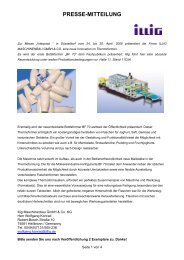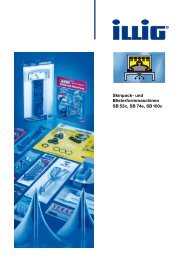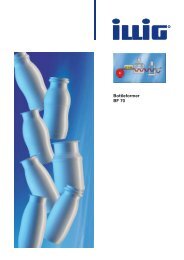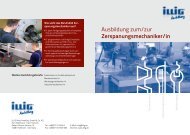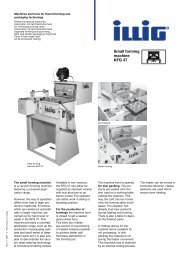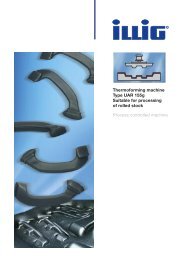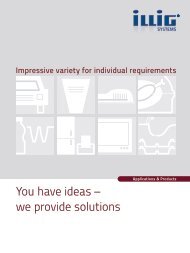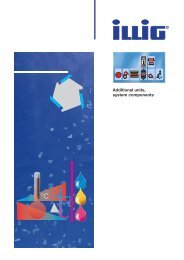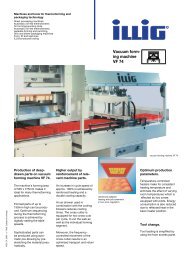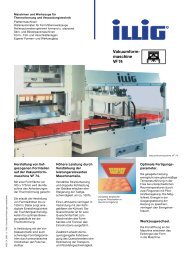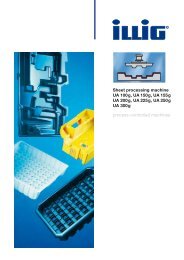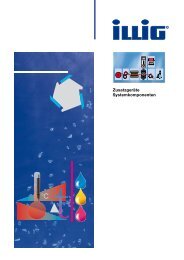Thermoforming - ILLIG Maschinenbau GmbH & Co. KG
Thermoforming - ILLIG Maschinenbau GmbH & Co. KG
Thermoforming - ILLIG Maschinenbau GmbH & Co. KG
Create successful ePaper yourself
Turn your PDF publications into a flip-book with our unique Google optimized e-Paper software.
PS CPET APET PP PLA<br />
Food is a valuable product. Protecting<br />
it along the value-adding chain from<br />
the producer to the retailer and on<br />
to the consumer, thus allowing it to be<br />
brought to the table fresh and appetizing,<br />
is the stated ambition of Færch Plast A/S<br />
(www.faerchplast.com), the Danish packaging<br />
specialist. The company is headquartered<br />
at Holstebro, a town of<br />
34,000 situated in picturesque<br />
north-western Jutland,<br />
close to the North Sea<br />
and the Limfjord – the<br />
long stretch of water<br />
which links the<br />
North Sea to the<br />
west with the Kattegat<br />
in the east<br />
and has been dividing<br />
Vendsyssel-Thy, Denmark’s<br />
second largest island, from<br />
southern Jutland since the<br />
flood of 1825.<br />
Since its formation in 1969,<br />
Færch Plast has built a name for itself<br />
as a leading developer and manufacturer<br />
of high-quality food packaging. Working<br />
around the clock, the company produces<br />
plastic packaging for diverse applications<br />
by thermoforming. The bulk of its products<br />
consists of trays of different shape, color<br />
and functionality for primary ready meals<br />
and fresh meat, but also for salads, snacks<br />
and other cold food products. These trays<br />
are made of sheets consisting of polyethylene<br />
terephthalate (PET) – more specifically,<br />
semi-crystalline CPET and amorphous<br />
APET – even polypropylene (PP), polystyrene<br />
(PS) and even polylactic acid (PLA), a<br />
so-called biopolymer.<br />
The company supplies its products to<br />
the food processing and retail industry,<br />
with<br />
exports –<br />
destined mainly<br />
for the entire European market – accounting<br />
for around 80% of its output.<br />
Attractive jobs – ambitious<br />
corporate policy<br />
A job with Færch Plast is considered highly<br />
attractive employment in the region. “To<br />
us, our employees are our most important<br />
resource. With their skills and commitment,<br />
they are key to our ability to keep on<br />
increasing our competitiveness and to remain<br />
on a constant growth path”, acknowledges<br />
Lars Gade Hansen, the company’s<br />
managing director.<br />
As a manufacturer catering to the foodstuffs<br />
industry, Færch Plast has always<br />
been convinced that its foodstuff packaging<br />
should meet the same high hygiene standard<br />
as the food itself. Thus, specific headgear<br />
or protective clothing must be worn in<br />
all production areas, depending on the individual<br />
job activity. All production employees<br />
are issued fresh work wear every day.<br />
Similarly, production technologies<br />
and processes at Færch Plast have been<br />
required to comply with hygiene, product<br />
safety and quality standards from the<br />
start. Thanks to this approach, the company<br />
quickly won hygiene certification by<br />
ADAS, the British research and consulting<br />
organization, in 1998. Today its certification<br />
conforms to the internationally recognized<br />
BRC/IoP standard developed by the British<br />
Retail <strong>Co</strong>nsortium (BRC) and the Institute of<br />
Packaging (IoP).<br />
Environmental and energy management<br />
are likewise key themes in the company’s<br />
policy. “In 1996, at the request of the<br />
public authorities, we started to measure<br />
our climate impact. But we did not stop<br />
at measuring – instead, we initiated and<br />
implemented environmental improvement<br />
steps systematically”, explains Lars Gade<br />
Hansen. The company has thus managed<br />
to cut its annual energy consumption by<br />
29% since 1996. In terms of kilowatt hours,<br />
this figure corresponds to the annual power<br />
demand of 4,400 households. As its next<br />
goal, Færch Plast is determined to meet its<br />
entire energy requirement from renewable<br />
resources as of 2012. “Our objective<br />
for 2009 was to get 40% of our energy<br />
from renewable sources, and this we have<br />
achieved. For this year we have now raised<br />
the bar to 53%, and we are going to meet<br />
that target as well”, Hansen adds. This will<br />
mean that Færch Plast has cut its impact<br />
on the global climate (expressed in socalled<br />
CO 2<br />
equivalents) by more than onehalf<br />
since 1996.<br />
From1996 until today, Færch Plast has<br />
reduced its climate impact by one-half.<br />
thermoformer 1/2010 11



